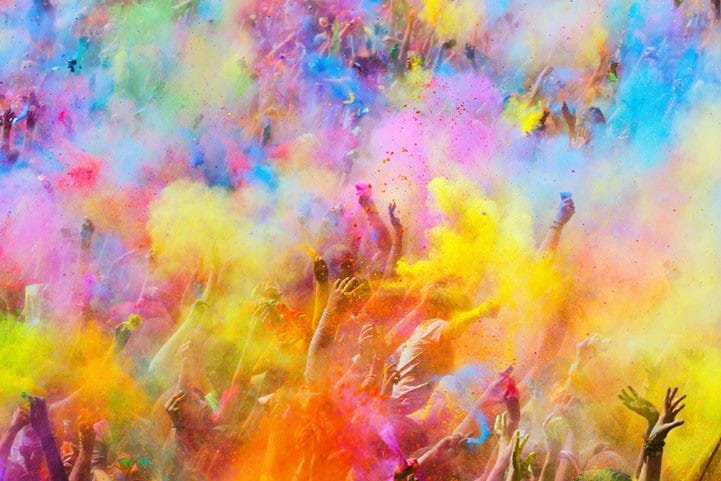Holi – the festival of colours


Holi, as we all know, is a festival full of colours, which is celebrated in the entire world with abundant joy and happiness. It is also a festival of unity as it brings people together to celebrate a festival regardless of caste, ethnicity or religion. Holi is celebrated for two days in India on the full moon day in March. People celebrate “Holika Dahan” on the first day by gathering around and burning piles of wood and cow dung, and singing bhajans related to Holi.By worshipping on this day, the person gets rid of all kinds of troubles from their life. Then on the next day, people of all ages gather together to play with colours called “gulal” and coloured water called “Dulahandi”. People feast together and eat special sweets made for the day called “gujiya” and serve “thandai” or cold drinks and “bhaang”.
On the main day of holi, the entire streets and towns turn red, green and yellow as people throw coloured powder into the air and splash them on others. Each colour carries a meaning. Red, for example, symbolises love and fertility while green stands for new beginnings, blue for lord krishna. People also splash water on each other in celebration. Water guns are used to squirt water, while balloons filled with coloured water are also flung from rooftops. Later in the day, families gather together for festive meals. It is also common to distribute sweets among neighbours and friends.
So many states of India celebrate holi as the biggest festival of the year. The festival garners the most attention from international vacationers among the religious festivals of India. This year, Holi is approaching with the Easter festival in tow, giving the most suitable time for foreign travellers to delight in the festivities. As Indians indulge in the play with coloured powders and pigments, foreigners join in the revelry and are open-heartedly welcomed. People are free to let their hair down and partake in the carousing. The most famous places for holi celebrations in India are Mathura, Vrindavan, Barsana, Agra, Udaipur, Jaipur, Hampi, Pushkar, Mumbai and even Punjab.
View this post on Instagram
Amongst all these places, Mathura is largely sought-after by devotees, most especially during Holi. Temples in Mathura host elaborate events to celebrate the festival. Some of these are the most spectacular and grandest Holi celebrations in India. Being a part of these festivities is a lifetime experience.Lord Krishna’s playland – Vrindavan, is another place which is highly revered by Hindus and frequented all through the year. Holi in Vrindavan is an occasion that receives a huge influx of Vaishnavas. Also, Barsana too, is among the top places for Holi celebrations in India. Holi celebrations in Barsana are also known as Lathmar Holi that intrigue people.
Whether you are in India or outside, Holi is one day every Indian eagerly waits for. In Australia, the occasion is made special with a run that takes place in Gold Coast. With such a massive Indian population, Australia is one of many countries where the festival of colours is just as spiritedly celebrated as at home. South Africa is another country flooded with individuals of Indian origins. Holi is enjoyed here by playing a free-for-all colour war, enjoying bonfires, and singing Holi songs. The vibrant Gujarati community in the African nation makes the festival so enticing that you definitely want to be a part of it. Spanish cities celebrate Holi in a different way. Spain has its own version of Holi called the Tomatina Festival where instead of colours the locals play with tomatoes.Canada is known for its large Punjabi population. Students at the University of British Columbia in Vancouver form an important aspect of multicultural diversity of the college. Holi is a significant festival of the Indian community in Canada.
Ideally, the joyous festival of Holi is meant to celebrate the arrival of Spring while the colours used in Holi are to reflect the various hues of the spring season. But unfortunately, in modern times Holi does not stand for all things beautiful. Like various other festivals, Holi too has become ruthlessly commercialised, boisterous and yet another source of environmental degradation. To de-pollute Holi and make it in sync with nature, as it is supposed to be, several social and environmental groups are proposing a return to more natural ways of celebrating Holi.
Holi is a festival of love, universal brotherhood, and goodwill among individuals and communities. This festival gives us the message of unity and brotherhood.



0 Comments